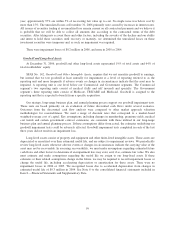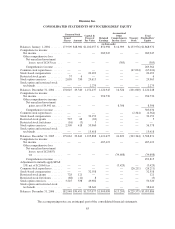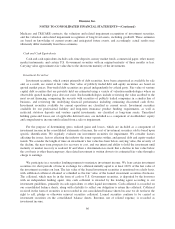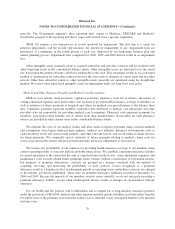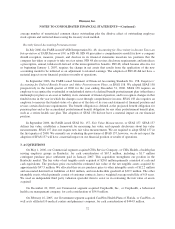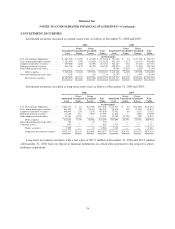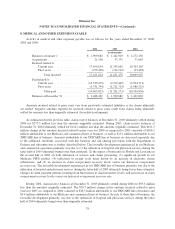Humana 2006 Annual Report Download - page 80
Download and view the complete annual report
Please find page 80 of the 2006 Humana annual report below. You can navigate through the pages in the report by either clicking on the pages listed below, or by using the keyword search tool below to find specific information within the annual report.Humana Inc.
NOTES TO CONSOLIDATED FINANCIAL STATEMENTS—(Continued)
at the contract level and recorded in our consolidated balance sheets in other current assets or trade accounts
payable and accrued expenses depending on the contract balance at the end of the reporting period.
For plans where we provide enhanced benefits and selected the alternative demonstration payment option in
lieu of the reinsurance subsidy, we receive a monthly per member capitation amount from CMS determined from
our annual bid submissions. The capitation amount we receive from CMS for assuming the government’s portion
of prescription drug costs in the catastrophic layer of coverage is recorded as premium revenue. The variance
between the capitation amount and actual drug costs in the catastrophic layer is subject to risk sharing as part of
the risk corridor settlement.
See Note 5 for detail regarding amounts recorded to the consolidated balance sheets related to the risk
corridor settlement and subsidies from CMS.
TRICARE
We account for the TRICARE South Region contract under EITF Issue No. 00-21, Accounting for Revenue
Arrangements with Multiple Deliverables, and as such allocate the consideration to the various components of
the contract based on the relative fair value of the components. TRICARE revenues consist generally of (1) an
insurance premium for assuming underwriting risk for the cost of civilian health care services delivered to
eligible beneficiaries; (2) health care services provided to beneficiaries which are in turn reimbursed by the
federal government; and (3) administrative service fees related to claim processing, customer service, enrollment,
disease management and other services. We recognize the insurance premium as revenue ratably over the period
coverage is provided. Health care services reimbursements are recognized as revenue in the period health
services are provided. Administrative services fees are recognized as revenue in the period services are
performed. Our TRICARE South Region contract contains provisions to share the risk associated with financing
the cost of health benefits with the federal government. We earn more revenue or incur additional costs based on
the variance of actual health care costs versus a negotiated target cost. We defer the recognition of any contingent
revenues for favorable variances until the amount is determinable and the collectibility is reasonably assured. We
estimate and recognize contingent medical expense for unfavorable variances currently in our results of
operations. We continually review the contingent medical expense estimates of future payments to the
government for cost overruns and make necessary adjustments to our reserves.
Revenues also may include change orders and bid price adjustments attributable to our TRICARE contracts.
Change orders represent equitable adjustments for services not originally specified in the contracts. Bid price
adjustments, or BPAs, represent adjustments defined in our former contracts subject to negotiations with the
federal government. Revenues for these adjustments are recognized when a settlement amount becomes
determinable and the collectibility is reasonably assured.
ASO Fees
ASO fees are recognized as income in the period services are performed. ASO fees cover the processing of
claims, offering access to our provider networks and clinical programs, and responding to customer service
inquiries from members of self-funded groups. Under ASO contracts, self-funded employers retain the risk of
financing substantially all of the cost of health benefits. However, most ASO customers purchase stop loss
insurance coverage from us to cover catastrophic claims or to limit aggregate annual costs. Accordingly, we have
recorded premiums and medical expenses related to these stop loss arrangements.
Premium and ASO fee receivables are shown net of allowances for estimated uncollectible accounts and
retroactive membership adjustments. Premiums and ASO fees received prior to the service period are recorded as
unearned revenues.
68



